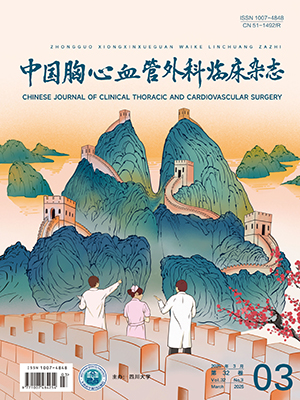| 1. |
Qu Y, Liu X, Zhuang J, et al. Incidence of congenital heart disease: the 9-year experience of the Guangdong Registry of Congenital Heart Disease, China. PLoS One, 2016, 11(7): e0159257.
|
| 2. |
Khairy P, Clair M, Fernandes SM, et al. Cardiovascular outcomes after the arterial switch operation for D-transposition of the great arteries. Circulation, 2013, 127(3): 331-339.
|
| 3. |
Schidlow DN, Jenkins KJ, Gauvreau K, et al. Transposition of the great arteries in the developing world: surgery and outcomes. J Am Coll Cardiol, 2017, 69(1): 43-51.
|
| 4. |
Jacobs ML, Jacobs JP, Hill KD, et al. The Society of Thoracic Surgeons Congenital Heart Surgery Database: 2018 update on research. Ann Thorac Surg, 2018, 106(3): 654-663.
|
| 5. |
Losay J, Touchot A, Serraf A, et al. Late outcome after arterial switch operation for transposition of the great arteries. Circulation, 2001, 104(12 Suppl 1): Ⅰ121-Ⅰ126.
|
| 6. |
Prifti E, Crucean A, Bonacchi M, et al. Early and long term outcome of the arterial switch operation for transposition of the great arteries: predictors and functional evaluation. Eur J Cardiothorac Surg, 2002, 22(6): 864-873.
|
| 7. |
Lalezari S, Bruggemans EF, Blom NA, et al. Thirty-year experience with the arterial switch operation. Ann Thorac Surg, 2011, 92(3): 973-979.
|
| 8. |
Fricke TA, d'Udekem Y, Richardson M, et al. Outcomes of the arterial switch operation for transposition of the great arteries: 25 years of experience. Ann Thorac Surg, 2012, 94(1): 139-145.
|
| 9. |
Oda S, Nakano T, Sugiura J, et al. Twenty-eight years' experience of arterial switch operation for transposition of the great arteries in a single institution. Eur J Cardiothorac Surg, 2012, 42(4): 674-679.
|
| 10. |
Gittenberger-de-Groot AC, Sauer U, Oppenheimer-Dekker A, et al. Coronary arterial anatomy in transposition of the great arteries: A morphological study. Pediatric Cardiology, 1983, 4(Suppl): 15-24.
|
| 11. |
Wernovsky G, Wypij D, Jonas RA, et al. Postoperative course and hemodynamic profile after the arterial switch operation in neonates and infants. A comparison of low-flow cardiopulmonary bypass and circulatory arrest. Circulation, 1995, 92(8): 2226-2235.
|
| 12. |
Davidson J, Tong S, Hancock H, et al. Prospective validation of the vasoactive-inotropic score and correlation to short-term outcomes in neonates and infants after cardiothoracic surgery. Intensive Care Med, 2012, 38(7): 1184-1190.
|
| 13. |
Kim HJ, Fay MP, Feuer EJ, et al. Permutation tests for joinpoint regression with applications to cancer rates. Stat Med, 2000, 19(3): 335-351.
|
| 14. |
Belsley DA, Kuh E, Welsch RE. Regression diagnostics: Identifying influential data and sources of Collinearity. 1st ed. Hoboken: John Wiley & Sons, 2004.
|
| 15. |
Fine JP, Gray RJ. A Proportional hazards model for the subdistribution of a competing risk. J Am Stat Assoc, 1999, 94(446): 496-509.
|
| 16. |
Liu YL, Hu SS, Shen XD, et al. Safety and efficacy of arterial switch operation in previously inoperable patients. J Card Surg, 2010, 25(4): 400-405.
|
| 17. |
Huang JB, Cao YT, Liang J, et al. Quality of life after children undergo a radical arterial switch operation at an older age. Heart Surg Forum, 2012, 15(2): E103-E107.
|
| 18. |
Ma K, Hua Z, Yang K, et al. Arterial switch for transposed great vessels with intact ventricular septum beyond one month of age. Ann Thorac Surg, 2014, 97(1): 189-195.
|
| 19. |
Feng B, Liu Y, Hu S, et al. Arterial switch for transposition of the great vessels and Taussig-Bing anomaly after six months of age. Ann Thorac Surg, 2009, 88(6): 1948-1951.
|
| 20. |
Edwin F, Mamorare H, Brink J, et al. Primary arterial switch operation for transposition of the great arteries with intact ventricular septum--is it safe after three weeks of age? Interact Cardiovasc Thorac Surg, 2010, 11(5): 641-644.
|
| 21. |
Bisoi AK, Sharma P, Chauhan S, et al. Primary arterial switch operation in children presenting late with d-transposition of great arteries and intact ventricular septum. When is it too late for a primary arterial switch operation? Eur J Cardiothorac Surg, 2010, 38(6): 707-713.
|
| 22. |
Ismail SR, Kabbani MS, Najm HK, et al. Early outcome for the primary arterial switch operation beyond the age of 3 weeks. Pediatr Cardiol, 2010, 31(5): 663-667.
|
| 23. |
Bisoi AK, Ahmed T, Malankar DP, et al. Midterm outcome of primary arterial switch operation beyond six weeks of life in children with transposition of great arteries and intact ventricular septum. World J Pediatr Congenit Heart Surg, 2014, 5(2): 219-225.
|
| 24. |
Castaneda AR, Trusler GA, Paul MH, et al. The early results of treatment of simple transposition in the current era. J Thorac Cardiovasc Surg, 1988, 95(1): 14-28.
|
| 25. |
Popov AF, Tirilomis T, Giesler M, et al. Midterm results after arterial switch operation for transposition of the great arteries: a single centre experience. J Cardiothorac Surg, 2012, 7: 83.
|
| 26. |
Villafañe J, Lantin-Hermoso MR, Bhatt AB, et al. D-transposition of the great arteries: the current era of the arterial switch operation. J Am Coll Cardiol, 2014, 64(5): 498-511.
|
| 27. |
Tobler D, Williams WG, Jegatheeswaran A, et al. Cardiac outcomes in young adult survivors of the arterial switch operation for transposition of the great arteries. J Am Coll Cardiol, 2010, 56(1): 58-64.
|
| 28. |
Xiao Y, Zhang P, Su W, et al. Early and mid-term follow-up of patients receiving arterial switch operation: a single-center experience. J Thorac Dis, 2018, 10(2): 732-739.
|
| 29. |
Pasquali SK, Hasselblad V, Li JS, et al. Coronary artery pattern and outcome of arterial switch operation for transposition of the great arteries: A meta-analysis. Circulation, 2002, 106(20): 2575-2580.
|
| 30. |
Ma K, Li S, Hu S, et al. Neoaortic valve regurgitation after arterial switch: Ten years outcomes from a single center. Ann Thorac Surg, 2016, 102(2): 636-642.
|




